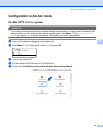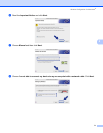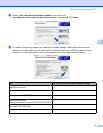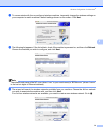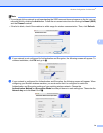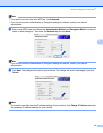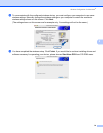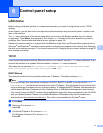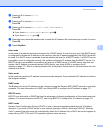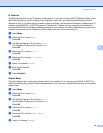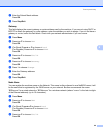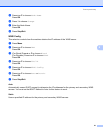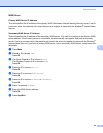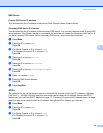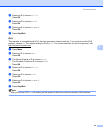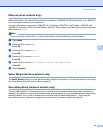
Control panel setup
78
6
d Press a or b to choose TCP/IP.
Press OK.
e Press a or b to choose BOOT Method.
Press OK.
f Press a or b to choose Auto, Static, RARP, BOOTP or DHCP.
Press OK.
If you chose Auto, RARP, BOOTP or DHCP, go to g.
If you chose Static, go to h.
g Enter how many times the machine tries to obtain the IP address. We recommend you to enter 3 or more.
Press OK.
h Press Stop/Exit.
Auto mode 6
In this mode, the machine will scan the network for a DHCP server, if it can find one, and if the DHCP server
is configured to allocate an IP address to the machine, then the IP address supplied by the DHCP server will
be used. If no DHCP server is available, then the machine will scan for a BOOTP server. If a BOOTP server
is available, and it is configured correctly, the machine will take its IP address from the BOOTP server. If a
BOOTP server is not available, the machine will scan for a RARP server. If a RARP server also does not
answer, the IP Address is scanned through APIPA facility, see Using APIPA to configure the IP
address on page 171. After it is initially powered ON, it may take a few minutes for the machine to scan the
network for a server.
Static mode 6
In this mode the machine’s IP address must be manually assigned. Once entered the IP address is locked to
the assigned address.
RARP mode
6
The Brother print server IP address can be configured using the Reverse ARP (RARP) service on your host
computer. For more information on RARP, see Using RARP to configure the IP address on page 171.
BOOTP mode 6
BOOTP is an alternative to RARP that has the advantage of allowing configuration of the subnet mask and
gateway. For more information on BOOTP, see Using BOOTP to configure the IP address on page 170.
DHCP mode
6
Dynamic Host Configuration Protocol (DHCP) is one of several automated mechanisms for IP address
allocation. If you have a DHCP server in your network (typically a UNIX
®
, Windows
®
2000/XP, Windows
Vista™ network) the print server will automatically obtain its IP address from a DHCP server and register its
name with any RFC 1001 and 1002 compliant dynamic name services.



